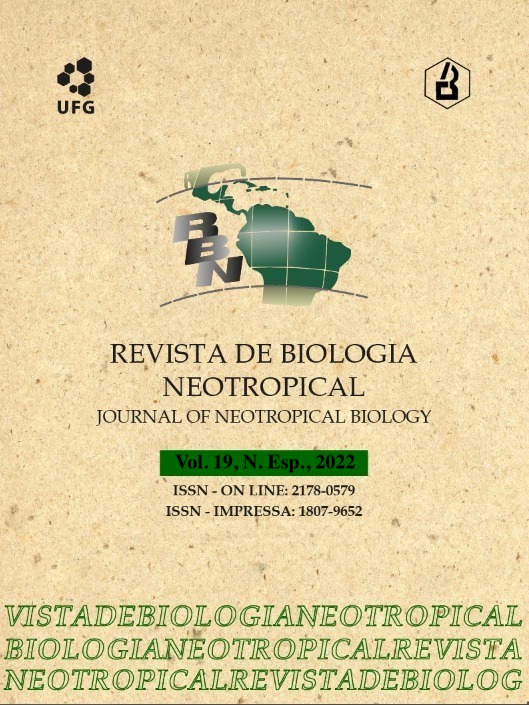Reparação da pele no sapo terrestre Melanophryniscus montevidensis (Philippi, 1902): uma abordagem experimental
DOI:
https://doi.org/10.5216/rbn.v19iesp.73885Palavras-chave:
anfíbios, cicatrização, histología, anestesia, MelanophryniscusResumo
Estudamos neste trabalho o processo de cicatrização da pele do sapo terrestre Melanophryniscus montevidensis. Espécimes selvagens foram aclimatados em laboratório e uma ferida cutânea experimental de 1,5 mm de diâmetro foi feita na região do dorso sob anestesia com óleo de cravo, deixando a derme exposta. O acompanhamento do processo cicatricial por histologia convencional foi feito até 129 dias. A proteção epidérmica da ferida foi recuperada após 2 dias, e aparentemente uma recuperação completa das estruturas glandulares dérmicas foi evidente após 37 dias. Esta característica inclui as glândulas serosas que desempenham um papel relevante na estratégia defensiva desta espécie. Não foram registradas complicações do procedimento anestésico, não avaliadas previamente em Melanophryniscus.
Downloads
Referências
AFIP. Armed Forces Institute of Pathology. 1949. Routine staining procedures. pp. 32-46. In: Manual of histologic staining methods. 2rd ed. New York, McGraw-Hill.
Altig, R. 1980. A convenient killing agent for amphibians, Herp. Rev. 11(2): 35.
Brunetti, A., G. Hermida, M. Lurman & J. Faivovich. 2016. Odorous secretions in anurans: morphological and functional assessment of serous glands as a source of volatile compounds in the skin of the treefrog Hypsiboas pulchellus (Amphibia: Anura: Hylidae). J. Anat. 228(3): 430-442.
Delfino, G., R. Brizzi, R. Kracke-Berndorff & B. Alvarez. 1998. Serous gland Dimorphism in the Skin of Melanophryniscus stelzneri (Anura: Bufonidae). J. Morphol 237(1): 19-32.
Duellman, W. E. & L. Trueb. 1986. Biology of Amphibians. Baltimore, London, The Johns Hopkins University Press, 670 p.
Ferraro, D. R., P. E. Topa & G. N. Hermida. 2013. Lumbar glands in the frog genera Pleurodema and Somuncuria (Anura: Leiuperidae): histological and histochemical perspectives. Acta Zool. 94(1): 44–57.
Fox, H. 1994. The structure of the integument. pp. 1-32. In: Heatwole, H. & G. T. Barthalamus (Eds.). Amphibian Biology, Vol. 1, The Integument. Sidney, Surrey Beatty & Sons.
Frost, D. 2022. Amphibian species of the world 6.0. An on-line reference. Available in: <https://amphibiansoftheworld.amnh.org/>. Accessed 21 Aug. 2022.
Hantak, M. M., T. Grant, S. Reinsch, D. Mcginnity, M. Loring, N. Toyooka & R. A. Saporito. 2013. Dietary alkaloid sequestration in a poison fog: an experimental test of alkaloid uptake in Melanophryniscus stelzneri (Bufonidae). J. Chem. Ecol. 39(11-12): 1400-1406.
Hernández, S., C. Sernia & A. Bradley. 2012. The effect of three anaesthetic protocols on the stress response in cane toads (Rhinella marina). Vet. Anaest. Analg. 39(6): 584-590.
Kawasumi, A., Sagawa, N., Hayashi, S., Yokoyama, H. & K. Tamura. 2013. Wound healing in mammals and amphibians: toward limb regeneration in mammals. Curr. Top. Microbiol. Immunol. 367: 33-49.
Kolenc, F. 1988. Anuros del género Melanophryniscus en la República Oriental del Uruguay. Aquamar 30: 16-21.
Leévesque, M., É. Villiard & S. Roy. 2010. Skin wound healing in axolotls: a scarless process. J. Exp. Zool. B (Mol. Devel. Evol.). 314(8): 684-697.
Luna, M. C., R. W. McDiarmid & J. Faivovich. 2018. From erotic excrescences to pheromone shots: structure and diversity of nuptial pads in anurans. Biol. J. Linn. Soc. 124(3): 403–446.
Mangione, S. & M. Alcaide. 1994. Histología de piel del parche pélvico en referencia a piel dorsal y ventral, en Menaophryniscus rubiventris subcondolor (Anura, Bufonidae). Bol. Asoc. Herp. Arg. 10(1): 28-30.
McClanahan, L. L. Jr., V. H. Shoemaker & R. Ruibal. 1976. Structure and function of the cocoon of a ceratophryd frog. Copeia. 1976(1): 179-185.
Mitchell, M. A. 2009. Anesthetic considerations for amphibians. J. Exot. Pet Med. 18(1): 40-49.
Naya, D. E., J. A. Langone & R. O. de Sá. 2004. Histological features of the frontal tumefaction in Melanophryniscus (Amphibia: Anura: Bufonidae). Rev. Chil. Hist. Nat. 77(4): 593-598.
Otuska-Yamaguchi, R., A. Kawasumi-Kita, N. Kudo, Y. Izutsu, K. Tamura & H. Yokoyama. 2017. Cells from subcutaneous tissues contribute to scarless skin regeneration in Xenopus laevis froglets. Dev. Dyn. 246(8): 585-597.
Sadeghipour, A. & P. Babaheidarian. 2019. Making formalin-fixed, paraffin embedded blocks. pp. 253-268. In: Yong, W. H. (Ed.). Biobanking: Methods and Protocols, Methods in Molecular Biology. New York, Humana Press.
Tedros, M., F. Kolenc & C. Borteiro. 2001. Melanophryniscus montevidensis. (Phillipi, 1902) (Anura, Bufonidae). Cuad. Herpetol. 15(2): 143.
Toledo, L. F. & C. F. B. Haddad. 2009. Colors and some morphological traits as defensive mechanisms in anurans. Int. J. Zool. 2009(1-4): 1-12.
Yannas, I. V., J. Colt & Y. C. Wai. 1996. Wound contraction and scar synthesis during development of the amphibian Rana catesbeiana. Wound Repair Regen. 4(1): 29-39.
Yokoyama, H., T. Maruoka & A. Aruga. 2011. Prx-1 Expression in Xenopus laevis scarless skin-wound healing and its resemblance to epimorphic regeneration. J. Inv. Dermatol. 131(12): 2477-2485.
Yokoyama, H., Kudo, N., Todate, M., Shimada, Y., Susuki, M. & K. Tamura. 2018. Skin regeneration of amphibians: A novel model for skin regeneration as adults. Develop. Growth Differ. 00: 1-10.
Downloads
Publicado
Como Citar
Edição
Seção
Licença
Copyright (c) 2023 Revista de Biologia Neotropical / Journal of Neotropical Biology

Este trabalho está licenciado sob uma licença Creative Commons Attribution-NonCommercial 4.0 International License.
O envio espontâneo de qualquer submissão implica automaticamente na cessão integral dos direitos patrimoniais à Revista de Biologia Neotropical / Journal of Neotropical Biology (RBN), após a sua publicação. O(s) autor(es) concede(m) à RBN o direito de primeira publicação do seu artigo, licenciado sob a Licença Creative Commons Attribution 4.0 (CC BY-NC 4.0).
São garantidos ao(s) autor(es) os direitos autorais e morais de cada um dos artigos publicados pela RBN, sendo-lhe(s) permitido:
1. Uso do artigo e de seu conteúdo para fins de ensino e de pesquisa.
2. Divulgar o artigo e seu conteúdo desde que seja feito o link para o Artigo no website da RBN, sendo permitida sua divulgação em:
- redes fechadas de instituições (intranet).
- repositórios de acesso público.
3. Elaborar e divulgar obras derivadas do artigo e de seu conteúdo desde que citada a fonte original da publicação pela RBN.
4. Fazer cópias impresas em pequenas quantidades para uso pessoal.















